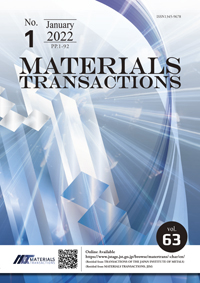
- Issue 5 Pages 455-
- Issue 4 Pages 357-
- Issue 3 Pages 243-
- Issue 2 Pages 109-
- Issue 1 Pages 1-
- |<
- <
- 1
- >
- >|
-
Fakfa Payayam, Sutawee Jomrieng, Charoenkwan Kraiya, Somchai Kiatgamol ...Article type: Regular Article
2024 Volume 65 Issue 4 Pages 357-361
Published: April 01, 2024
Released on J-STAGE: March 25, 2024
Advance online publication: January 26, 2024JOURNAL RESTRICTED ACCESS FULL-TEXT HTMLGraphene nanoplatelets (GNPs) were synthesized by an electrochemical exfoliation method. Four various conditions of the electrochemical exfoliation process: (I) 1 M NaOH with 4 V, (II) 0.5 M H2SO4 with 5 V, (III) a mixture of 1 M NaOH and 0.5 M H2SO4 with 5 V, and (IV) a two-step process of 1 M NaOH with 4 V and 0.5 M H2SO4 with 5 V, were compared. The as-synthesized GNPs obtained from all conditions were characterized by Raman spectroscopy and X-ray diffraction. The two-step process provided the GNPs with the low defect concentration and the lowest number of layers. Moreover, confirmed by field emission scanning and transmission electron microscopes (FE-SEM and TEM), the GNPs obtained from the two-step process were multilayer graphene. The GNPs obtained from each condition were added into an ultraviolet-cured acrylate adhesive to fabricate electrically conductive acrylate adhesive (ECAA). The GNPs acted as fillers to play an important role in conducting the electrical network of the ECAA without any other additive. The van der Pauw method was conducted to measure the electrical resistivity of the ECAA. The ECAA, containing 5 wt% of the obtained GNPs from the two-step process, had the lowest resistivity when compared to the ECAA which contained the obtained GNPs from other conditions. We found that the percolation threshold of the ECAA, containing the obtained GNPs from the two-step process, was at 3.26 wt%. Last, 6.92 wt% of the GNPs reached the lowest resistivity at 1.09 Ω·cm.
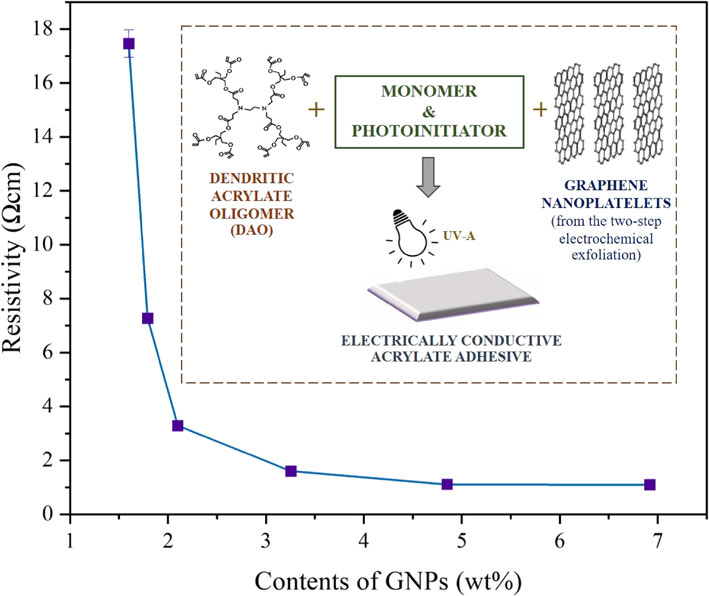 View full abstractDownload PDF (1378K) Full view HTML
View full abstractDownload PDF (1378K) Full view HTML -
T. Kawamata, R. Hayashi, K. Sugimoto, K. SugiyamaArticle type: Regular Article
2024 Volume 65 Issue 4 Pages 362-367
Published: April 01, 2024
Released on J-STAGE: March 25, 2024
Advance online publication: February 02, 2024JOURNAL RESTRICTED ACCESS FULL-TEXT HTMLThe topological and chemical short-range ordering (TSRO and CSRO) of Pd82Ge18 amorphous alloys prepared by the single-roll liquid quench method were analyzed using a combination of anomalous X-ray scattering and reverse Monte Carlo (RMC) simulation. The degree of development of TSRO and CSRO in the amorphous structure model made with the RMC simulation (RMC model) was evaluated by comparison with the dense random packing model (DRP model) calculated using metallic and covalent atomic radii. In the RMC model, a shortening of the Pd–Ge nearest neighbor correlation and a decrease in the coordination number around Ge were observed. Voronoi polyhedral analysis was performed to evaluate the local geometrical structure around the Pd and Ge atoms. Although the DRP structure can reasonably approximate the local structure around the Pd atoms, the TTP structure corresponding to the local structure in crystalline Pd2Ge develops around the Ge atoms as a characteristic TSRO. However, the preferential coordination of Pd atoms around Ge, which is a CSRO associated with the TTP structure in the crystalline phase, was not observed. These results indicate that strong CSRO does not necessarily accompany the TTP structures in metal-semimetal amorphous alloys.
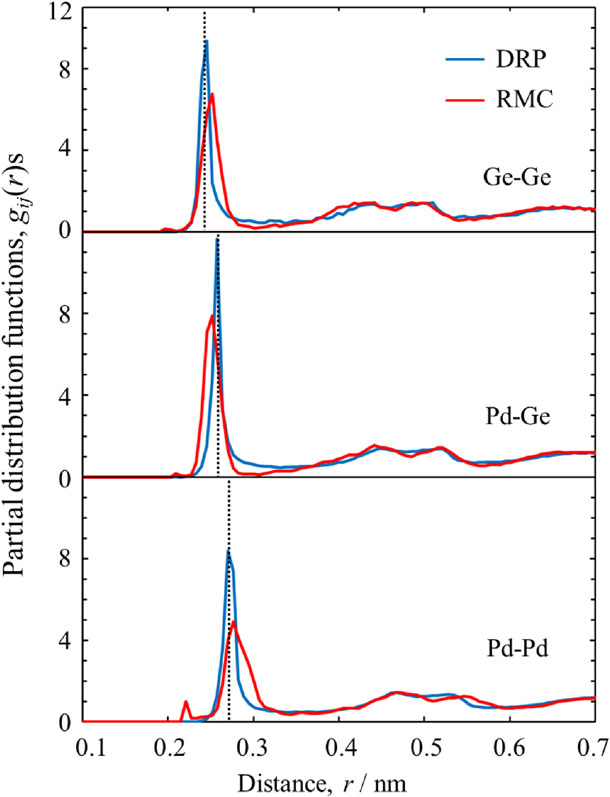 Fig. 3 Partial pair distribution functions, g(r)PdPd, g(r)PdGe, and g(r)GeGe calculated from the DRP and RMC models. Fullsize ImageView full abstractDownload PDF (2160K) Full view HTML
Fig. 3 Partial pair distribution functions, g(r)PdPd, g(r)PdGe, and g(r)GeGe calculated from the DRP and RMC models. Fullsize ImageView full abstractDownload PDF (2160K) Full view HTML
-
Yasutoshi Hideshima, Fumiya Maeda, Tadao Fukuta, Koichi OzakiArticle type: Regular Article
2024 Volume 65 Issue 4 Pages 368-373
Published: April 01, 2024
Released on J-STAGE: March 25, 2024
JOURNAL FREE ACCESS FULL-TEXT HTMLMagnesium chips were coated with silicon powder using a binder, and injection molding was performed using silicon-coated chips as the raw material. Microstructural analysis of the products revealed that all added silicon (Si) precipitated as Mg2Si particles, with no voids present at the interfaces between the Mg2Si particles and the matrix. Furthermore, the hardness and Young’s modulus of the products increased with higher Si content. The Young’s moduli followed the rules of mixtures.
This Paper was Originally Published in Japanese in J. Japan Inst. Met. Mater. 87 (2023) 186–191. Abstract and keywords were slightly modified. The captions of Fig. 3, Fig. 4, and Fig. 6 are slightly modified.
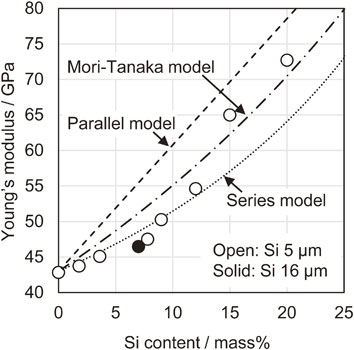 Fig. 8 Effect of Si addition on Young’s modulus with the rules of mixtures (Parallel model, Series model and Mori-Tanaka model). Fullsize ImageView full abstractDownload PDF (2730K) Full view HTML
Fig. 8 Effect of Si addition on Young’s modulus with the rules of mixtures (Parallel model, Series model and Mori-Tanaka model). Fullsize ImageView full abstractDownload PDF (2730K) Full view HTML -
Yasutoshi Hideshima, Fumiya Maeda, Tadao Fukuta, Koichi OzakiArticle type: Regular Article
2024 Volume 65 Issue 4 Pages 374-380
Published: April 01, 2024
Released on J-STAGE: March 25, 2024
JOURNAL FREE ACCESS FULL-TEXT HTMLMagnesium chips were coated with a high concentration of graphite using a binder and were used as the raw material for injection molding. The microstructure of the magnesium injection-molded product with added graphite exhibited a dispersion of needle-like graphite particles. No significant voids were observed at the interfaces between the graphite and the matrix. The addition of more than 0.5 mass% graphite decreased the proof stress and tensile strength of the injection-molded products. The Young’s modulus of the graphite-added products tended to decrease with an increase in the graphite content, which is consistent with the lower limit of the rule of mixtures. The thermal conductivity of the 6.9 mass% graphite-added product increased compared with that of the AZ91D magnesium alloy and the coefficient of linear thermal expansion decreased. Both values are within a range that satisfied the rules of mixtures.
This Paper was Originally Published in Japanese in J. Japan. Inst. Met. Mater. 86 (2022) 237–244. Abstract is slightly modified. The captions of Fig. 3, Fig. 4, and Fig. 10 are slightly modified.
 Microstructure of graphite-dispersed magnesium matrix composites and interface between matrix and graphite. Fullsize ImageView full abstractDownload PDF (4205K) Full view HTML
Microstructure of graphite-dispersed magnesium matrix composites and interface between matrix and graphite. Fullsize ImageView full abstractDownload PDF (4205K) Full view HTML
-
Takaaki WajimaArticle type: Regular Article
2024 Volume 65 Issue 4 Pages 381-388
Published: April 01, 2024
Released on J-STAGE: March 25, 2024
JOURNAL RESTRICTED ACCESS FULL-TEXT HTMLA Cs-adsorbent including tobermorite was successfully synthesized from debris-treated ash via an alkali treatment. Tobermorite synthesis was examined as a function of the reaction temperature, time, solid/liquid ratio, and NaOH concentration. The formation of tobermorite was identified in the product treated with a 2–5-M NaOH solution, with a solid/liquid ratio of 50–250 g/L, at 180°C after a 24-h reaction. As the reaction temperature increased, tobermorite was rapidly synthesized owing to the rapid dissolution of Si and Al from the ash. The product, which was treated with 2.0-M NaOH solution (250 g/L) at 180°C for 24 h, indicated the high selective uptake ability for Cs+ in saline water. On increasing the solution pH, the adsorption of Cs+ increased and remained almost constant above a pH of 6. The Cs+ uptake ability of the product was extrapolated using the Langmuir and Freundlich isotherm models, was found to fit the Langmuir model better than the Freundlich model, and the calculated uptake ability was 0.36 mmol/g. The kinetics for the Cs+ uptake ability was tested for pseudo-second-order reactions, and the rate constants of the uptake were calculated. Regardless of the temperature of the aqueous solution, the kinetics of the uptake and the uptake of Cs+ were almost the same.
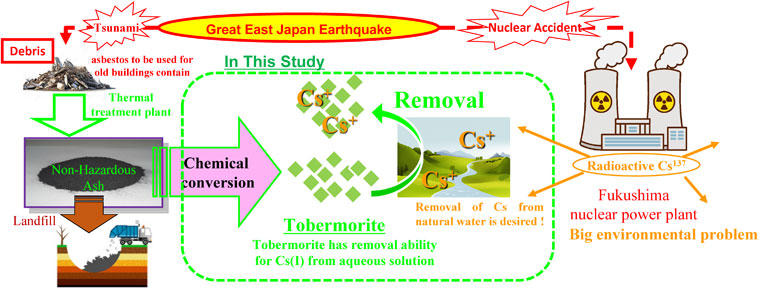 View full abstractDownload PDF (2058K) Full view HTML
View full abstractDownload PDF (2058K) Full view HTML -
Md. Saiful Islam, Masatoshi Sakairi, Akira Kaneko, Md. Shakhawat Hossa ...Article type: Regular Article
2024 Volume 65 Issue 4 Pages 389-397
Published: April 01, 2024
Released on J-STAGE: March 25, 2024
Advance online publication: February 02, 2024JOURNAL RESTRICTED ACCESS FULL-TEXT HTMLThe results of the corrosion nature of aluminum 7075 alloy in a cation-containing aqueous medium are reported by using gravimetric tests and surface analysis. The investigation showed a substantial increase in the mass of the specimens after the immersion experiments, while a minor mass change was seen in the Zn2+ containing solution. Energy dispersive spectroscopic mapping and cross-sectional pictures showed that the specimen submerged in the Zn2+ containing solution developed a zinc-linked layer. The results of X-ray photoelectron spectroscopy showed that aluminum hydroxide was deposited on the surface, and a tiny amount was deposited on the specimen that was sunk in the solution containing Zn2+. The present study suggests that the zinc-related layer prevents the alloy from corroding.
View full abstractDownload PDF (8223K) Full view HTML
-
Mohammed Shahien, Kentaro Shinoda, Masato Suzuki, Hideyuki Takagi, Nor ...Article type: Regular Article
2024 Volume 65 Issue 4 Pages 398-404
Published: April 01, 2024
Released on J-STAGE: March 25, 2024
Advance online publication: January 26, 2024JOURNAL RESTRICTED ACCESS FULL-TEXT HTMLIn pursuit of achieving zero-emission power generation, the utilization of carbon-free fuels like H2 holds promise for enhancing the reliability of the next-generation turbines. To realize the necessary of new operational environment, the implementation of dense environmental barrier coatings (EBCs) becomes essential. This study delves into the investigation of the durability of dense Al2O3 coatings deposited using the Hybrid Aerosol Deposition (HAD) method under the harsh condition of a high-speed steam-jet test, operating at approximately 125 m/s and elevated temperatures. The durability assessment encompasses uncoated SUS304 substrates and SUS304 substrates with dense HAD Al2O3 coatings deposited on one side. These samples underwent a rigorous 20-hour steam-jet test within a temperature range of 600–800°C.
Results indicate that the erosion rate of uncoated SUS304 substrates steadily increased with temperature, reaching a recession rate of 4.4 µm/h at the point of impingement. Conversely, the erosion rate was nearly halved following the deposition of HAD Al2O3 coating on one side of the substrates. The dense 8–9 µm Al2O3 coatings applied via HAD exhibited exceptional environmental protection during continuous exposure to the high-speed steam-jet at temperatures up to 800°C for 20 hours. Furthermore, the HAD layer effectively prevented oxygen penetration into the substrate. Post-test analysis revealed no significant features at the coating-substrate interface. Importantly, there were no alterations in the lattice parameter of Al2O3 crystal post-test. The coatings remained exclusively composed of the α-Al2O3 phase, with gradual crystallinity recovery driven by thermal effects during the steam-jet test and increasing temperature. These findings underscore the robust durability of HAD Al2O3 coatings in demanding high-speed steam-jet environments, making them a promising solution for enhancing power generation reliability.
View full abstractDownload PDF (3126K) Full view HTML -
Yuri Honda, Haruhisa ShiomiArticle type: Regular Article
2024 Volume 65 Issue 4 Pages 405-413
Published: April 01, 2024
Released on J-STAGE: March 25, 2024
Advance online publication: January 26, 2024JOURNAL RESTRICTED ACCESS FULL-TEXT HTMLZnO is synthesized by aging layered zinc hydroxide acetate, ZHA, as a precursor. The effects of type and concentration of alkaline earth metal ions on the crystal growth of ZnO were studied by synthesizing ZnO by aging ZHA in calcium acetate (CaAc), strontium acetate (SrAc), and barium acetate (BaAc) aqueous solutions at various concentrations. In all cases, ZnO particles elongated in the c-axis direction were obtained, and the aspect ratio increased with increasing ion concentration. Especially, in BaAc solution, the longest particles in the c-axis direction were observed. This is due to the small hydration ionic radius of barium, which is easily adsorbed on the side of ZnO. When aging ZHA in 2.0 mol/L of BaAc solution, agglomerated particles were formed in the early stage of aging, and the growth of individual particles in the agglomerate and entire agglomerated particles proceeded in parallel, resulting in particles with characteristic bouquet-shapes. In conclusion, the c-axis growth of ZnO is controlled by the type and concentration of alkaline earth metal ions.
View full abstractDownload PDF (8089K) Full view HTML -
Asuka Suzuki, Terumasa Fujishiro, Naoki Takata, Makoto KobashiArticle type: Regular Article
2024 Volume 65 Issue 4 Pages 414-421
Published: April 01, 2024
Released on J-STAGE: March 25, 2024
Advance online publication: January 26, 2024JOURNAL RESTRICTED ACCESS FULL-TEXT HTMLThe combustion foaming process enables the fabrication of closed-cell porous intermetallics by utilizing the combustion reactions generating a large amount of heat. A closed-cell porous Al3Ti (D022 crystal structure) fabricated by the combustion foaming process has a lightweight, high stiffness, high melting temperature, and good oxidation resistance but exhibits brittleness due to the poor deformability of Al3Ti. It is known that the addition of third elements (X = Cr, Mn, Fe, etc.) changes the crystal structures from D022 to L12, resulting in an improvement in the deformability in the case of dense materials. In the present study, an attempt was made to fabricate the closed-cell porous (Al, Fe)3Ti with an L12-ordered crystal structure through the combustion foaming. The effect of the amount of the exothermic agent, which was added to control the reaction heat of combustion foaming, on the porosity, pore morphology, microstructure, and constituent phases was investigated. The closed-cell porous L12-(Al, Fe)3Ti without any intermediate phases was successfully fabricated when the exothermic agent was added over 5 vol%. The porosity reached the maximum at approximately 80% when the exothermic agent of 10 vol% was added. The TiB2 particles, which were formed by the reactions of the exothermic agent, were aggregated in the porous sample with the exothermic agent of 5 vol% but uniformly dispersed in the porous samples foamed with the exothermic agent over 10 vol%. Based on the results above and the temperature measurements during the combustion foaming, it is important for fabricating highly porous L12-(Al, Fe)3Ti with the uniform microstructure to control the maximum temperature just above the liquidus temperature of (Al, Fe)3Ti. This study provides new insights into the hierarchical control of porous materials with the desired pore structures and cell wall materials.
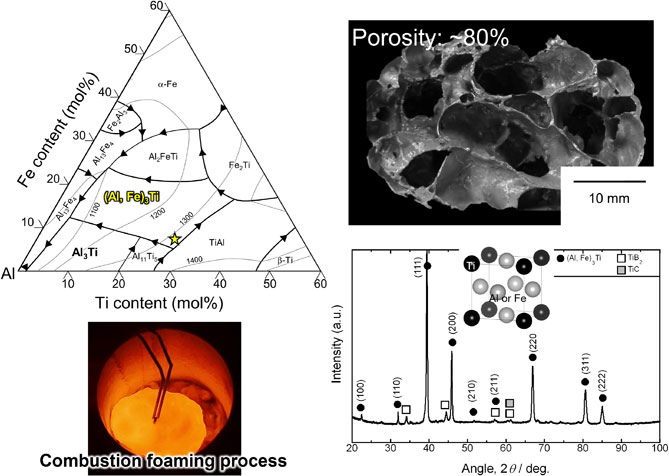 View full abstractDownload PDF (4742K) Full view HTML
View full abstractDownload PDF (4742K) Full view HTML
-
Norihiko Hamada, Takashi Horikawa, Katsunari Oikawa, Satoshi SugimotoArticle type: Regular Article
2024 Volume 65 Issue 4 Pages 422-427
Published: April 01, 2024
Released on J-STAGE: March 25, 2024
JOURNAL RESTRICTED ACCESS FULL-TEXT HTMLInternal permanent magnet motors suffer from leakage flux in their rotor core bridges, which can be removed through the partial non-magnetization of the bridges. In a previous study, a process was proposed in which the bridged portion of the silicon steel sheet was non-magnetized after pressing by melting, an Ni–Cr alloy powder was added to the silicon steel sheet using a laser, and the rotor core was produced via lamination. However, because the final solidification step produced solidification defects, such as cracks and shrinkage cavities, a homogenous alternative step that does not produce solidification defects needs to be developed. To reduce the area of improvement, we previously investigated a chemical composition that suppressed solidification defect formation. The addition of B to the improved portion suppressed the formation of cracks and shrinkage cavities, and a crack-suppression mechanism was proposed. In this study, we focus on the mechanism of shrinkage cavity suppression. We determine that the solidification shrinkage rate decreases owing to the precipitation of Cr2B, which has a lower density than the austenite phase, and results in the suppression of the shrinkage cavities. Minimization of the area of non-magnetic improvement is possible by suppressing solidification defects. Consequently, the laser processing speed per piece and amount of expensive nickel are reduced. These new alloys show promise for practical partial non-magnetizing applications.
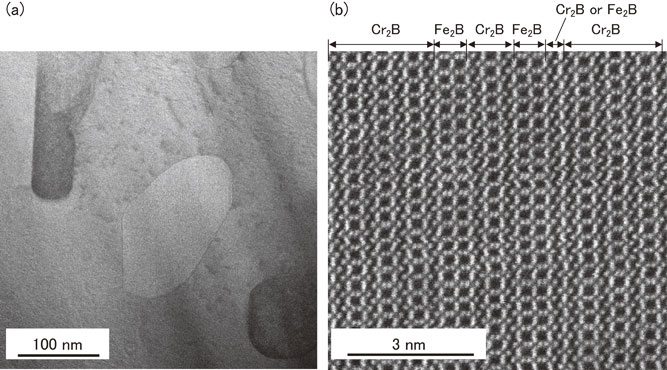 Adding B to the improved portion suppressed the formation of cracking and shrinkage voids. The mechanism for suppressing shrinkage voids was also revealed. The solidification shrinkage ratio decreased with the addition of B. Only a few eutectic structures were observed in the sample without B, whereas the sample containing a B content of 0.9% showed several eutectic structures. The left-most photograph shows the precipitates in the eutectic structure using STEM-HAADF imaging. The precipitates mainly consisted of the Cr2B phase. Subsequently, the solidification shrinkage rate decreased owing to the precipitation of Cr2B, which has a lower density than the austenite phase, and the formation of shrinkage cavities was suppressed. Fullsize ImageView full abstractDownload PDF (4638K) Full view HTML
Adding B to the improved portion suppressed the formation of cracking and shrinkage voids. The mechanism for suppressing shrinkage voids was also revealed. The solidification shrinkage ratio decreased with the addition of B. Only a few eutectic structures were observed in the sample without B, whereas the sample containing a B content of 0.9% showed several eutectic structures. The left-most photograph shows the precipitates in the eutectic structure using STEM-HAADF imaging. The precipitates mainly consisted of the Cr2B phase. Subsequently, the solidification shrinkage rate decreased owing to the precipitation of Cr2B, which has a lower density than the austenite phase, and the formation of shrinkage cavities was suppressed. Fullsize ImageView full abstractDownload PDF (4638K) Full view HTML -
Nobuo Nagashima, Masao Hayakawa, Hiroyuki Masuda, Kotobu NagaiArticle type: Regular Article
2024 Volume 65 Issue 4 Pages 428-433
Published: April 01, 2024
Released on J-STAGE: March 25, 2024
Advance online publication: February 09, 2024JOURNAL FREE ACCESS FULL-TEXT HTMLFatigue limit is well predicted by tensile strength or hardness, and the relationship is often analyzed by linear regression using the minimum squared approximation. However, the prediction of the number of cycles to failure at a given stress amplitude, meaning the estimate of the S–N curve, has not been realized. Therefore, we aim to investigate the estimability of the S–N curve using the random forest method based on the data described in the NIMS fatigue data sheet. The random forest method is a machine learning algorithm and an ensemble learning algorithm that integrates weak learners of multiple decision tree models to improve generalization ability. It was clarified that the machine learning of the multiple decision tree model is excellent in fatigue limit prediction. The S–N curve can be accurately estimated by combining the prediction of fatigue limit and the number of cycles to failure at a given stress amplitude.
This Paper was Originally Published in Japanese in J. Soc. Mater. Sci., Japan 70 (2021) 876–880.
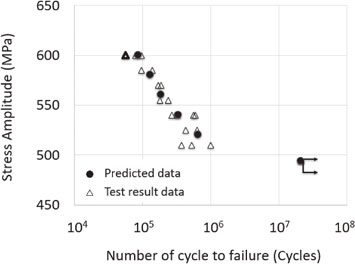 Fig. 9 Prediction of S-N curve of fracture life using data of S25C, S35C, S55C, SNCM439, SmN438, SmN43, SUS403, SUS304 (data of fracture life of 5 × 106 times or less, fatigue limit considers only hardness). Fullsize ImageView full abstractDownload PDF (2807K) Full view HTML
Fig. 9 Prediction of S-N curve of fracture life using data of S25C, S35C, S55C, SNCM439, SmN438, SmN43, SUS403, SUS304 (data of fracture life of 5 × 106 times or less, fatigue limit considers only hardness). Fullsize ImageView full abstractDownload PDF (2807K) Full view HTML -
Tomomi Iihara, Yuki Ito, Kosei Fukuoka, Kenichiro Suehiro, Kazunari Ma ...Article type: Regular Article
2024 Volume 65 Issue 4 Pages 434-439
Published: April 01, 2024
Released on J-STAGE: March 25, 2024
Advance online publication: January 26, 2024JOURNAL FREE ACCESS FULL-TEXT HTMLOxygen-free copper is an integral part of electric vehicles and renewable energy initiatives as the key conductor material owing to its high conductive properties. However, the poor heat resistance and poor stress relaxation resistance characteristics pose challenges for applications involving heat. This study aims to explore the potential for developing a new pure copper material with enhanced heat resistance and stress relaxation resistance characteristics while maintaining conductivity. Trace amounts of solute elements Mg, Sn, P, Ti, and Ag were added to oxygen-free copper, and the following results were obtained from the cold-rolled material:
(1) Mg, Sn, P, Ti, or Ag addition below 500 at ppm has little effect on yield strength.
(2) Mg or Ag addition below 200 at ppm has little effect on electrical conductivity.
(3) Mg or Sn addition above 100 at ppm increases the half-softening temperature to over 573 K.
(4) Mg, Sn, or Ag addition above 100 at ppm increases the residual stress ratio to over 60%.
(5) Mg or Ag addition yields a superior balance of electrical conductivity, half-softening temperature, and residual stress ratio; particularly, Mg addition between 100 and 200 at ppm results in an excellent balance.
This Paper was Originally Published in Japanese in J. Japan Inst. Copper 62 (2023) 251–256 with slight modifications, such as adjustment to the calculated half-softening temperatures for more accurate representation.
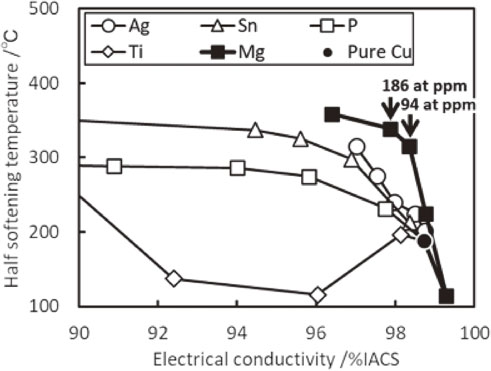 View full abstractDownload PDF (2119K) Full view HTML
View full abstractDownload PDF (2119K) Full view HTML -
Hanjung Kwon, Jaemin Song, Doyeon Lee, Jonghyuck Jeon, Jin-Young LeeArticle type: Regular Article
2024 Volume 65 Issue 4 Pages 440-446
Published: April 01, 2024
Released on J-STAGE: March 25, 2024
JOURNAL RESTRICTED ACCESS FULL-TEXT HTMLThis study enhanced the efficiency in the milling process of preparing SiC powder using the source recycled from Si sludge as a raw material. The sludge, which is formed during machining Si wafer, intrinsically contains SiC (abrasive material), thus due to the high hardness of SiC, the milling effect on the Si sources with sludge was expected to be higher than that of the pure Si. Indeed, the SiC included intrinsically in the sludge resulted in more effective milling of the sludge–carbon mixture; and after high-energy ball milling, the crystallite size of Si in the mixture decreased to 26.8 nm, while the crystallite size of Si in the source without sludge was 49.5 nm. The increase of milling effect in the sludge contributed to the low reaction temperature, improved the sinterability, and reduced the grain size of the sintered SiC. Finally, using the sludge as a raw material, SiC of high density, refined microstructure, and enhanced hardness (Hv: 29.5 GPa, previously reported Hv: (23.7–26) GPa) was obtained. These results suggest that the use of sludge can be an effective way to produce SiC with refined microstructure and enhanced properties, as well as to reduce the cost of production of SiC parts.
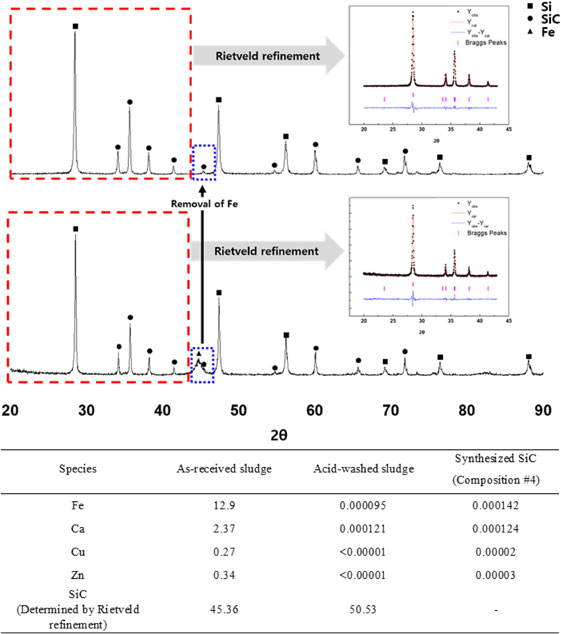 View full abstractDownload PDF (3290K) Full view HTML
View full abstractDownload PDF (3290K) Full view HTML
-
Salmawati, Yuichi Sugai, Kyuro SasakiArticle type: Regular Article
2024 Volume 65 Issue 4 Pages 447-453
Published: April 01, 2024
Released on J-STAGE: March 25, 2024
Advance online publication: February 02, 2024JOURNAL RESTRICTED ACCESS FULL-TEXT HTMLIncreasing global temperatures due to high atmospheric carbon dioxide (CO2) concentrations may cause an imbalance in the carbon circulation on earth. It has been reported that CO2 emissions from natural soils in all terrestrial areas on Earth account for about 25% of atmospheric CO2 emissions in the global carbon cycle. A tendency is well known that the higher the soil temperature with the higher the metabolic activity of microorganisms in the soil. Furthermore, since the global soil CO2 emissions are huge amount that approximately seven times the total atmospheric CO2 emissions from human origin, it is necessary to investigate the increasing rate of soil CO2 emission rate per unit area and unit time on a global scale (global soil CO2 efflux) that is affected by soil temperature rise due to global warming expected in the coming decades.
In this paper, we modeled soil CO2 efflux vs. diurnal and seasonal variation in soil temperature at a measurement point using a formula that is an exponential function of soil temperature and then evaluated the effect of increasing average soil temperature due to surface air temperature rise by global warming. We have proposed a method to analogically evaluate the potential of increasing the rate of soil CO2 efflux against a change of 1°C in soil temperature based on the model equation. The power index b (°C−1) just indicates the potential of increasing the rate of soil CO2 efflux to soil temperature rise in any land area with different soil temperatures on earth. Finally, the values of b were obtained from the published literature with field measurement data at 71 locations in 10 countries including our data measured at the Ito campus, Kyushu University. The average rate of potential increase in soil CO2 efflux is 0.10°C−1 regardless of vegetation, annual rainfall (precipitation), soil type, and soil components (carbon and nitrogen content). In conclusion, assuming the average soil temperature rises by 1°C and ignoring any effects reducing soil CO2 reduction due to global warming, the potential increase in annual global soil CO2 efflux is roughly estimated at 22 billion tons-CO2/year.
View full abstractDownload PDF (2869K) Full view HTML
- |<
- <
- 1
- >
- >|